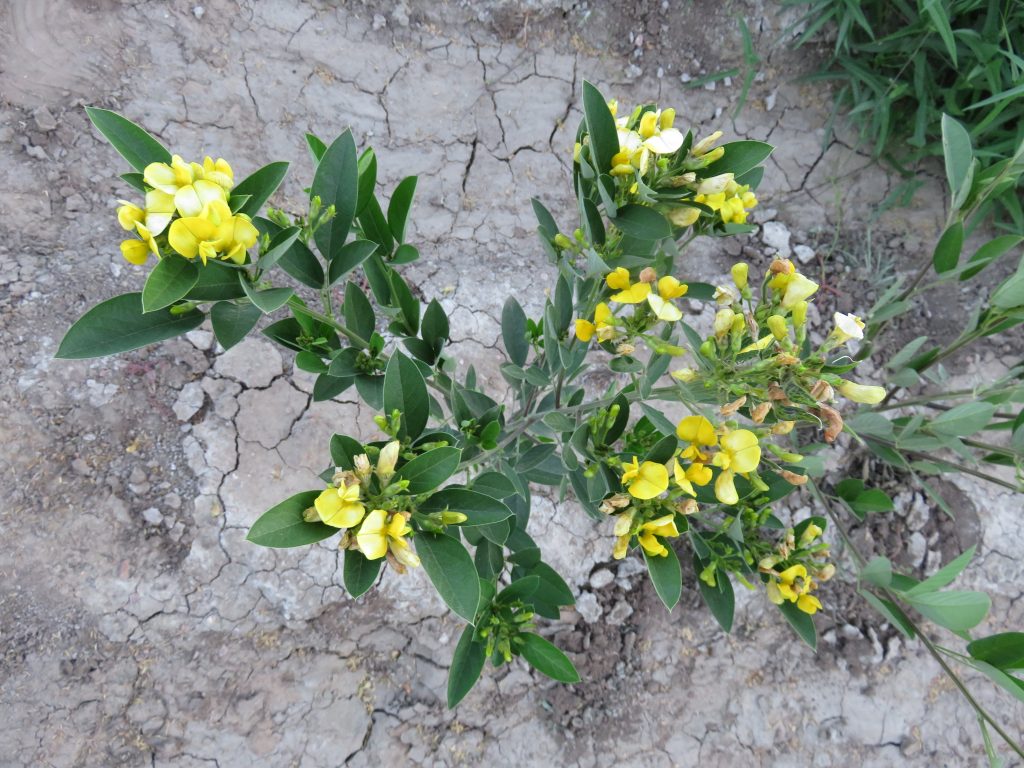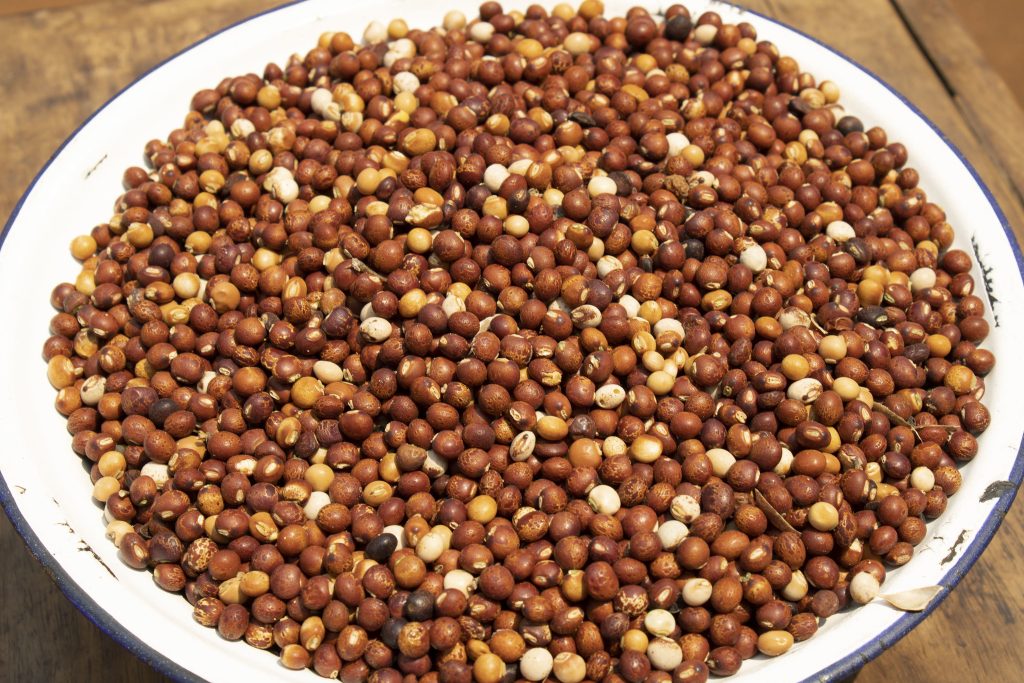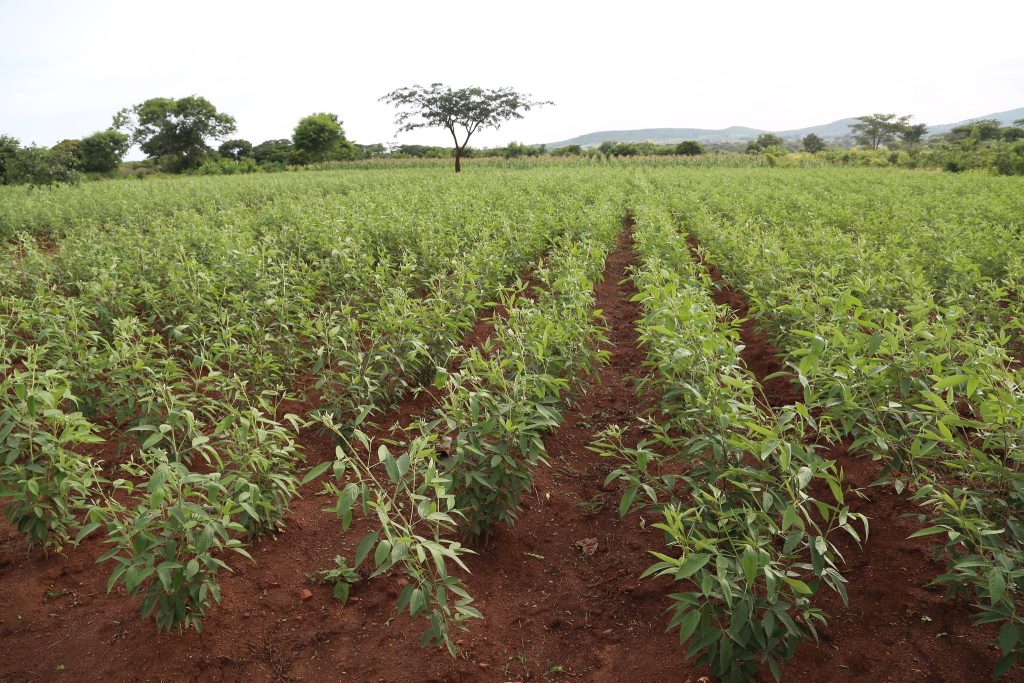Pigeon Pea (Cajanus cajan)
Patricia Henderson
Colorado State University, Fort Collins, Colorado 80523
Corresponding author: patricia.henderson@colostate.edu; patrick.byrne@colostate.edu
OUTLINE
1. OVERVIEW

Cajanus cajan, commonly referred to as pigeon pea, is the sixth most important edible legume crop globally. It is known for its adaptability and quick growth (Abebe, 2022). While mainly grown in semi-arid tropical regions, pigeon peas do well in many types of soils, have a strong tolerance to drought, and are able to yield well even in less favorable conditions. Pigeon pea is one of the most underutilized legume crops, even with its benefits of a significant level of nutrients and strong medicinal properties.
Pigeon pea is a short-lived perennial, most often grown as an annual. It has a deep root network well adapted to semi-arid conditions. Plants can grow to a height of 3 to 10 feet, with slender leaves, yellow or red flowers, and pods of various colors (CGIAR Genebank Platform, 2019). Their seed pods are long with two to nine large seeds (Rana & Kaushik, 2018).
2. HISTORY

It is generally agreed that pigeon peas originated in India (Upadhyaya et al., 2013). The CGIAR Genebank Platform (2019) states that the crop was domesticated there about 3500 years ago, later reaching Africa, where it spread rapidly. It was further spread to the Americas through the African slave trade (CGIAR Genebank Platform, 2019).
3. PRODUCTION AND USE

Pigeon peas are the sixth largest grain legume crop globally in terms of cultivated area and production (Emefiene et al., 2014). Currently, the largest producers of pigeon pea are India (70% of the total area), Myanmar, Malawi, Tanzania, and Kenya, aligning with the crop’s strong tolerance to hot and semi-arid conditions.
Pigeon pea, while an often-underutilized crop, is excellent at maintaining a reasonable crop yield with less than optimal environmental conditions. It has properties like drought tolerance, nitrogen fixation, ability to reduce soil erosion, and adaptability to a range of soil types. Pigeon peas are fast growers in the right conditions and tend to be very adaptable to their environments (Abebe, 2022). Based on the climate conditions in which it is grown, the crop varies in maturation speed. In drier conditions, it matures faster, while in humid weather, maturity occurs later (Rana & Kaushik, 2018). Pigeon peas are sensitive to temperature levels and the amount of light they receive, making frost and low sun detrimental to maturation speed and pod development (Rana & Kaushik, 2018). As such, pigeon peas are most commonly found as a crop in tropical and subtropical areas with dry climates.
The entire plant is utilized in subsistence agricultural systems: as a human food (both green and mature peas), for animal feed (leaves, seeds, husks, and pod shells), and as a household fuel (dry stems) (Rana & Kaushik, 2018). It is also grown as a green manure fertilizer (CGIAR Genebank Platform, 2019). Pigeon peas are processed into products such as noodles, biscuits, flour, and bread (Fatokimi & Tanimonure, 2021). Nutritionally, they have significant fiber, fat, and protein levels (average of 21%). Protein deficiency is common in topical/subtropical regions, making legumes, including pigeon peas in rainfed areas, one of the main sources of protein (Abebe, 2022).
Pigeon peas are recognized in the pharmaceutical industry as a useful medicine (Rana & Kaushik, 2018). China and India specifically use them in traditional medicines due to their high levels of various nutrients and phytochemicals (Emefiene et al., 2014). They are believed to have anti-inflammatory, antibacterial, antioxidant, anticarcinogenic, and antidiabetic properties (Abebe, 2022).
4. CONSERVATION AND BREEDING

Pigeon peas are usually stored in genebanks as dried seeds under low temperature and moisture levels to preserve their viability for longer periods of time. The largest collection of the species is held at the International Crops Research Institute for the Semi-Arid Tropics (ICRISAT) in India, with over 13,000 accessions, including landraces, breeding lines, and wild relatives (Upadhyaya et al., 2013). Other major collections are in the national genebank systems of India and Kenya. Pigeon peas have a high potential for outbreeding, allowing for a wide diversity in traits and genes (Khan, 1973). As cross-pollination can occur up to 40% of the time due to bees and other pollinators, it is best to be aware that desirable traits might be hard to preserve without direct intervention to control pollination (CGIAR Genebank Platform, 2019).
Pigeon pea accessions possess significant variability for days to flowering (<50 to >160 days) and days to maturity (85 to 270 days), and both determinate and nondeterminate types are available (Vales et al., 2012). The species varies for other important traits as well, including disease resistance, abiotic stress tolerance, seed size, seed shape, and number of seeds per pod (Zhao et al., 2020). However, the current cultivated germplasm is considered to have a narrow genetic base (Upadhyaya et al., 2013) that would benefit from incorporation of additional diversity.
Due to climate change, droughts and high temperatures have become more frequent, a trend that is expected to continue. One of the current goals in breeding pigeon peas has been to improve tolerance to heat stress and low water availability. Other breeding objectives include resistance or tolerance to disease and insect pests and improved nutritional properties (Upadhyaya et al., 2013).
Relatively little genetic research has been conducted with pigeon peas, as they are less established and utilized than other major legume crops like cowpeas and soybeans. However, increased research attention is now being directed to pigeon pea. A pangenome based on 89 sequenced accessions and representing the entire set of genes of the species was recently reported (Zhao et al., 2020). This pangenome should serve as a helpful resource for utilizing the genetic diversity of pigeon pea germplasm for crop improvement.
5. REFERENCES
Abebe BK. 2022. The dietary use of pigeon pea for human and animal diets. The Scientific World 4873008-4873012. DOI: 10.1155/2022/4873008
CGIAR Genebank Platform. 2019. Pigeonpea. CGIAR Genebank Platform. Accessed 26 July, 2022. Available from: genebanks.org/resources/crops/pigeon-pea
Emefiene ME, Joshua VI, Nwadike C, Yaroson AY, Zwalnan NDE. 2014. Profitability analysis of pigean pea (Cajanus cajan) production in Riyom LGA of Plateau State. International Letters of Natural Sciences 18:73-88. DOI: 10.56431/p-ogjgt1
Fatokimi EO, Tanimonure VA. 2021. Analysis of the current situation and future outlooks for pigeon pea (Cajanus cajan) production in Oyo State, Nigeria: A Markov Chain model approach. Journal of Agriculture and Food Research 6:100218. DOI: 10.1016/j.jafr.2021.100218
Khan TN. 1973. A new approach to the breeding of pigeon pea (Cajanus cajan Millsp.): formation of composites. Euphytica 22:373-377. DOI: 10.1007/BF00022649
Rana MK, Kaushik P. 2017. Pigeon pea. In: Rana MK (Ed.) Vegetable Crops Science, 1st ed. CRC Press. pp. 715-722. DOI: 10.1201/9781315116204-78
Upadhyaya HD, Sharma S, Reddy KN, Saxena R, Varshney RK, et al. 2013. Pigeonpea. In: Singh M, Upadhyaya HD, and Bisht IS (Eds.) Genetic and Genomic Resources of Grain Legume Improvement, Elsevier. p. 181-202. DOI: 10.1016/B978-0-12-397935-3.00008-6
Vales MI, Srivastava RK, Sultana R, Singh S, Singh I, et al. 2012. Breeding for earliness in pigeonpea: Development of new determinate and nondeterminate lines. Crop Science 52:2507-2516. DOI: 10.2135/cropsci2012.04.0251
Zhao J, Bayer PE, Ruperao P, Saxena RK, Khan AW, et al. 2020. Trait associations in the pangenome of pigeon pea (Cajanus cajan). Plant Biotechnology Journal 18:1946-1954. DOI: 10.1111/pbi.13354
6. CHAPTER INFORMATION
Chapter citation: Henderson P. 2023. Pigeon pea (Cajanus cajan). In: Chen K, Byrne P (Eds.) Understudied Indigenous Crops. Fort Collins, Colorado: Colorado State University. Date accessed. Available from https://colostate.pressbooks.pub/understudiedindigenouscrops/chapter/pigeon-pea/
Chapter editor: Patrick Byrne

